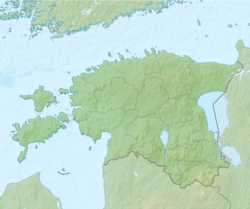Tallinn | |
|---|---|
| Coordinates: 59°26′14″N 24°44′43″E / 59.43722°N 24.74528°E | |
| Country | |
| County | Harju |
| First confirmed written record | 1219 |
| First possible appearance on map | 1154 |
| City rights | 1248 |
| Government | |
| • Mayor | Jevgeni Ossinovski |
| Area | |
| 159.2 km2 (61.5 sq mi) | |
| Elevation | 9 m (30 ft) |
| Population (2023)[2] | |
| 453,864 | |
| • Rank | 1st in Estonia |
| • Density | 2,900/km2 (7,400/sq mi) |
| • Urban | 638,076[1] |
| Demonym(s) | Tallinner (English) tallinlane (Estonian) |
| GDP | |
| • Capital city | €17.369 billion (US$18.3 billion) (2022) |
| • Per capita | €38,959 (US$41,055) (2022) |
| Time zone | UTC+2 (EET) |
| • Summer (DST) | UTC+3 (EEST) |
| ISO 3166 code | EE-784 |
| City budget | €1.26 billion[4] |
| Website | tallinn |
Tallinn (/ˈtælɪn/)[5][6] is the capital and most populous city of Estonia. Situated on a bay in north Estonia, on the shore of the Gulf of Finland of the Baltic Sea, Tallinn has a population of about 457,000 (as of 2024)[2] and administratively lies in the Harju maakond (county). Tallinn is the main governmental, financial, industrial, and cultural centre of Estonia. It is located 187 km (116 mi) northwest of the country's second largest city, Tartu; however, only 80 km (50 mi) south of Helsinki, Finland, also 320 km (200 mi) west of Saint Petersburg, Russia, 300 km (190 mi) north of Riga, Latvia, and 380 km (240 mi) east of Stockholm, Sweden. From the 13th century until the first half of the 20th century, Tallinn was known in most of the world by variants of its other historical name Reval.[7]
Tallinn received Lübeck city rights in 1248;[8] however, the earliest evidence of human population in the area dates back nearly 5,000 years.[9] The medieval indigenous population of what is now Tallinn and north Estonia was one of the last "pagan" civilisations in Europe to adopt Christianity following the Papal-sanctioned Livonian Crusade in the 13th century.[10][7] The first recorded claim over the place was laid by Denmark after a successful raid in 1219 led by King Valdemar II, followed by a period of alternating Scandinavian and Teutonic rulers. Due to the strategic location by the sea, its medieval port became a significant trade hub, especially in the 14–16th centuries, when Tallinn grew in importance as the northernmost member city of the Hanseatic League.[7] Tallinn Old Town is one of the best-preserved medieval cities in Europe and is listed as a UNESCO World Heritage Site.[11]
In 2012, Tallinn had the highest number of startup companies per person among all capitals and larger cities in Europe.[12] Tallinn is the birthplace of many international high-technology companies, including Skype and Wise.[13][7] The city is home to the headquarters of the European Union's IT agency,[14] and to the NATO Cyber Defence Centre of Excellence. In 2007, Tallinn was listed among the top-10 digital cities in the world,[15] and in 2022, Tallinn was listed among the top-10 "medium-sized European cities of the future".[16]
- ^ "Eurostat". eurostat.ec.europa.eu. Archived from the original on 19 June 2023. Retrieved 1 October 2023.
- ^ a b "Population by sex, age and place of residence after the 2017 administrative reform, 1 January". Statistics Estonia. Archived from the original on 14 July 2021. Retrieved 10 February 2024.
- ^ "GROSS DOMESTIC PRODUCT BY COUNTY". stat.ee. Archived from the original on 27 October 2022. Retrieved 16 December 2023.
- ^ "Tallinn's 2024 social sector budget focuses on strengthening social protection". tallinn.ee. Archived from the original on 16 December 2023. Retrieved 16 December 2023.
- ^ /ˈtælɪn/ TAL-in, US also /ˈtɑːlɪn/ TAH-lin(Estonian: [ˈtɑlʲːinː] )
- ^ "Definition of Tallinn". Encyclopedia2.thefreedictionary.com. Archived from the original on 15 August 2016. Retrieved 20 May 2012.
- ^ a b c d Spray, Aaron (30 January 2023). "Why Estonia's Historic Capital City Of Tallinn Is Worth Visiting". Thetravel.com. Archived from the original on 5 March 2023. Retrieved 5 March 2023.
- ^ "Tallinn on noorem, kui õpikus kirjas!". Delfi. 28 October 2003. Archived from the original on 29 August 2017. Retrieved 6 July 2017.
- ^ "Villu Kadakas: pringlikütid Vabaduse väljakul". 25 April 2009. Archived from the original on 16 August 2011. Retrieved 6 July 2017.
- ^ "Country Profile – LegaCarta". Archived from the original on 22 September 2020. Retrieved 26 November 2019.
- ^ "Historic Centre (Old Town) of Tallinn". UNESCO World Heritage Centre. 7 December 1997. Archived from the original on 5 January 2020. Retrieved 29 September 2013.
- ^ Rooney, Ben (14 June 2012). "The Many Reasons Estonia Is a Tech Start-Up Nation". The Wall Street Journal. Archived from the original on 25 March 2019. Retrieved 11 March 2017.
- ^ Germany, SPIEGEL ONLINE, Hamburg (14 March 2015). "Start-ups in Tallinn: Estland, das Silicon Valley Europas? – SPIEGEL ONLINE – Netzwelt". Der Spiegel. Archived from the original on 25 March 2019. Retrieved 28 April 2016.
{{cite news}}: CS1 maint: multiple names: authors list (link) - ^ Ingrid Teesalu (9 June 2011). "It's Official: Tallinn To Become EU's IT Headquarters". ERR. Archived from the original on 2 November 2011. Retrieved 27 April 2012.
- ^ "Tech capitals of the world". The Age. 15 May 2012. Archived from the original on 22 April 2012. Retrieved 20 May 2012.
- ^ Hankewitz, Sten (17 March 2022). "Tallinn in the top ten of the "Europe's cities of the future" ranking". Estonian World. Retrieved 7 October 2022.











